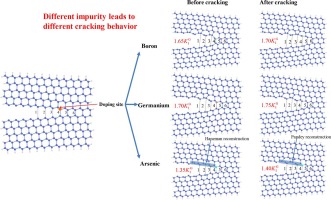当前位置:
X-MOL 学术
›
Comp. Mater. Sci.
›
论文详情
Our official English website, www.x-mol.net, welcomes your
feedback! (Note: you will need to create a separate account there.)
A density functional theory study on the lattice trapping of (1 1 1) [1 1¯0] crack system of silicon implanted by different impurities
Computational Materials Science ( IF 3.1 ) Pub Date : 2020-06-01 , DOI: 10.1016/j.commatsci.2020.109680 Bin Liu , Yun'an Zhang , Xinfeng Wang , Ziran Liu , Zhongbao Qin , Yingjuan Yue , Qiujuan Lv , Yanjiao Li
Computational Materials Science ( IF 3.1 ) Pub Date : 2020-06-01 , DOI: 10.1016/j.commatsci.2020.109680 Bin Liu , Yun'an Zhang , Xinfeng Wang , Ziran Liu , Zhongbao Qin , Yingjuan Yue , Qiujuan Lv , Yanjiao Li

|
Abstract Doped silicon (Si) is commonly applied in semiconductor industries. Different impurities impose different effects on the mechanical performance of Si micro/nano structures. In this work, we employ density functional theory (DFT) to investigate the influences of three typical substitutional impurities, boron (B), germanium (Ge) and arsenic (As) on the crack stability, characterized by lattice trapping, of (1 1 1) [1 1 ¯ 0] system. The impurities are located at the crack front. The simulations reveal that different impurities result in quite different crack advancing/healing behavior. The impurity B can greatly enhance the difficulty for crack propagation and healing. Therefore, the lattice trapping range is markedly expanded, indicating the elevated crack stability. In sharp contrast to B, when implanted with As, the crack tip advances under a notably lower load and heals more easily. The effects of Ge lie between B and As, i.e., the increased difficulty for crack propagation is close to B and that for crack healing is close to As. These impurities affect the lattice trapping mainly in two manners. The range and strength of interatomic interactions largely depend on the orbital hybridization when Si atoms bond with foreign atoms. Further, this can change the reconstruction pattern of the fractured surfaces near the crack front. Impurities B and Ge are more likely to promote Pandey reconstruction which is more stable than Haneman reconstruction, so that the cracks are more difficult to propagate or heal, while As has no such effect. Interestingly, the B doped system exhibits plasticity during healing process.
中文翻译:

不同杂质注入硅的(1 1 1) [1 1¯0]裂纹系统的晶格俘获密度泛函理论研究
摘要 掺杂硅 (Si) 广泛应用于半导体行业。不同的杂质对Si微/纳米结构的机械性能产生不同的影响。在这项工作中,我们采用密度泛函理论 (DFT) 来研究三种典型的置换杂质硼 (B)、锗 (Ge) 和砷 (As) 对裂纹稳定性的影响,裂纹稳定性以晶格俘获为特征,(1 1 1) [1 1¯ 0] 系统。杂质位于裂纹前沿。模拟结果表明,不同的杂质会导致完全不同的裂纹推进/愈合行为。杂质B会大大增加裂纹扩展和愈合的难度。因此,晶格俘获范围显着扩大,表明裂纹稳定性提高。与 B 形成鲜明对比的是,当植入 As 时,裂纹尖端在明显较低的载荷下前进并且更容易愈合。Ge的作用介于B和As之间,即裂纹扩展难度增加接近B,裂纹愈合增加难度接近As。这些杂质主要以两种方式影响晶格俘获。原子间相互作用的范围和强度很大程度上取决于 Si 原子与外来原子键合时的轨道杂化。此外,这可以改变裂纹前沿附近断裂表面的重建模式。杂质B和Ge更有可能促进Pandey重建,Pandey重建比Haneman重建更稳定,使裂缝更难扩展或愈合,而As没有这种影响。有趣的是,B 掺杂系统在愈合过程中表现出可塑性。Ge的作用介于B和As之间,即裂纹扩展难度增加接近B,裂纹愈合增加难度接近As。这些杂质主要以两种方式影响晶格俘获。原子间相互作用的范围和强度很大程度上取决于 Si 原子与外来原子键合时的轨道杂化。此外,这可以改变裂纹前沿附近断裂表面的重建模式。杂质B和Ge更有可能促进Pandey重建,Pandey重建比Haneman重建更稳定,使裂缝更难扩展或愈合,而As没有这种影响。有趣的是,B 掺杂系统在愈合过程中表现出可塑性。Ge的作用介于B和As之间,即裂纹扩展难度增加接近B,裂纹愈合增加难度接近As。这些杂质主要以两种方式影响晶格俘获。原子间相互作用的范围和强度很大程度上取决于 Si 原子与外来原子键合时的轨道杂化。此外,这可以改变裂纹前沿附近断裂表面的重建模式。杂质B和Ge更有可能促进Pandey重建,Pandey重建比Haneman重建更稳定,使裂缝更难扩展或愈合,而As没有这种影响。有趣的是,B 掺杂系统在愈合过程中表现出可塑性。裂纹扩展增加的难度接近 B,裂纹愈合增加的难度接近 As。这些杂质主要以两种方式影响晶格俘获。原子间相互作用的范围和强度很大程度上取决于 Si 原子与外来原子键合时的轨道杂化。此外,这可以改变裂纹前沿附近断裂表面的重建模式。杂质B和Ge更有可能促进Pandey重建,Pandey重建比Haneman重建更稳定,使裂缝更难扩展或愈合,而As没有这种影响。有趣的是,B 掺杂系统在愈合过程中表现出可塑性。裂纹扩展增加的难度接近 B,裂纹愈合增加的难度接近 As。这些杂质主要以两种方式影响晶格俘获。原子间相互作用的范围和强度很大程度上取决于 Si 原子与外来原子键合时的轨道杂化。此外,这可以改变裂纹前沿附近断裂表面的重建模式。杂质B和Ge更有可能促进Pandey重建,Pandey重建比Haneman重建更稳定,使裂缝更难扩展或愈合,而As没有这种影响。有趣的是,B 掺杂系统在愈合过程中表现出可塑性。原子间相互作用的范围和强度很大程度上取决于 Si 原子与外来原子键合时的轨道杂化。此外,这可以改变裂纹前沿附近断裂表面的重建模式。杂质B和Ge更有可能促进Pandey重建,Pandey重建比Haneman重建更稳定,使裂缝更难扩展或愈合,而As没有这种影响。有趣的是,B 掺杂系统在愈合过程中表现出可塑性。原子间相互作用的范围和强度很大程度上取决于 Si 原子与外来原子键合时的轨道杂化。此外,这可以改变裂纹前沿附近断裂表面的重建模式。杂质B和Ge更有可能促进Pandey重建,Pandey重建比Haneman重建更稳定,使裂缝更难扩展或愈合,而As没有这种影响。有趣的是,B 掺杂系统在愈合过程中表现出可塑性。而 As 没有这种效果。有趣的是,B 掺杂系统在愈合过程中表现出可塑性。而 As 没有这种效果。有趣的是,B 掺杂系统在愈合过程中表现出可塑性。
更新日期:2020-06-01
中文翻译:

不同杂质注入硅的(1 1 1) [1 1¯0]裂纹系统的晶格俘获密度泛函理论研究
摘要 掺杂硅 (Si) 广泛应用于半导体行业。不同的杂质对Si微/纳米结构的机械性能产生不同的影响。在这项工作中,我们采用密度泛函理论 (DFT) 来研究三种典型的置换杂质硼 (B)、锗 (Ge) 和砷 (As) 对裂纹稳定性的影响,裂纹稳定性以晶格俘获为特征,(1 1 1) [1 1¯ 0] 系统。杂质位于裂纹前沿。模拟结果表明,不同的杂质会导致完全不同的裂纹推进/愈合行为。杂质B会大大增加裂纹扩展和愈合的难度。因此,晶格俘获范围显着扩大,表明裂纹稳定性提高。与 B 形成鲜明对比的是,当植入 As 时,裂纹尖端在明显较低的载荷下前进并且更容易愈合。Ge的作用介于B和As之间,即裂纹扩展难度增加接近B,裂纹愈合增加难度接近As。这些杂质主要以两种方式影响晶格俘获。原子间相互作用的范围和强度很大程度上取决于 Si 原子与外来原子键合时的轨道杂化。此外,这可以改变裂纹前沿附近断裂表面的重建模式。杂质B和Ge更有可能促进Pandey重建,Pandey重建比Haneman重建更稳定,使裂缝更难扩展或愈合,而As没有这种影响。有趣的是,B 掺杂系统在愈合过程中表现出可塑性。Ge的作用介于B和As之间,即裂纹扩展难度增加接近B,裂纹愈合增加难度接近As。这些杂质主要以两种方式影响晶格俘获。原子间相互作用的范围和强度很大程度上取决于 Si 原子与外来原子键合时的轨道杂化。此外,这可以改变裂纹前沿附近断裂表面的重建模式。杂质B和Ge更有可能促进Pandey重建,Pandey重建比Haneman重建更稳定,使裂缝更难扩展或愈合,而As没有这种影响。有趣的是,B 掺杂系统在愈合过程中表现出可塑性。Ge的作用介于B和As之间,即裂纹扩展难度增加接近B,裂纹愈合增加难度接近As。这些杂质主要以两种方式影响晶格俘获。原子间相互作用的范围和强度很大程度上取决于 Si 原子与外来原子键合时的轨道杂化。此外,这可以改变裂纹前沿附近断裂表面的重建模式。杂质B和Ge更有可能促进Pandey重建,Pandey重建比Haneman重建更稳定,使裂缝更难扩展或愈合,而As没有这种影响。有趣的是,B 掺杂系统在愈合过程中表现出可塑性。裂纹扩展增加的难度接近 B,裂纹愈合增加的难度接近 As。这些杂质主要以两种方式影响晶格俘获。原子间相互作用的范围和强度很大程度上取决于 Si 原子与外来原子键合时的轨道杂化。此外,这可以改变裂纹前沿附近断裂表面的重建模式。杂质B和Ge更有可能促进Pandey重建,Pandey重建比Haneman重建更稳定,使裂缝更难扩展或愈合,而As没有这种影响。有趣的是,B 掺杂系统在愈合过程中表现出可塑性。裂纹扩展增加的难度接近 B,裂纹愈合增加的难度接近 As。这些杂质主要以两种方式影响晶格俘获。原子间相互作用的范围和强度很大程度上取决于 Si 原子与外来原子键合时的轨道杂化。此外,这可以改变裂纹前沿附近断裂表面的重建模式。杂质B和Ge更有可能促进Pandey重建,Pandey重建比Haneman重建更稳定,使裂缝更难扩展或愈合,而As没有这种影响。有趣的是,B 掺杂系统在愈合过程中表现出可塑性。原子间相互作用的范围和强度很大程度上取决于 Si 原子与外来原子键合时的轨道杂化。此外,这可以改变裂纹前沿附近断裂表面的重建模式。杂质B和Ge更有可能促进Pandey重建,Pandey重建比Haneman重建更稳定,使裂缝更难扩展或愈合,而As没有这种影响。有趣的是,B 掺杂系统在愈合过程中表现出可塑性。原子间相互作用的范围和强度很大程度上取决于 Si 原子与外来原子键合时的轨道杂化。此外,这可以改变裂纹前沿附近断裂表面的重建模式。杂质B和Ge更有可能促进Pandey重建,Pandey重建比Haneman重建更稳定,使裂缝更难扩展或愈合,而As没有这种影响。有趣的是,B 掺杂系统在愈合过程中表现出可塑性。而 As 没有这种效果。有趣的是,B 掺杂系统在愈合过程中表现出可塑性。而 As 没有这种效果。有趣的是,B 掺杂系统在愈合过程中表现出可塑性。











































 京公网安备 11010802027423号
京公网安备 11010802027423号